Question Generation: A Key Comprehension Strategy
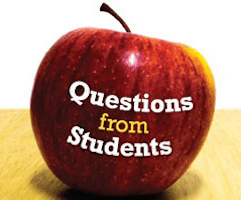
For this post, I want to focus on teaching students to generate their own questions while reading to improve comprehension. There is significant evidence that learning to generate questions while reading improves memory, integration and identification of main ideas, and overall comprehension (Rosenshine et al., 1996; National Reading Panel, 2000; Trabasso & Bouchard, 2002). Question generation is one of the four student strategy activities in The Key Comprehension Routine. You can take an online professional development workshop about how to teach question generation by going to the Keys to Literacy Teachable website.
Good readers automatically engage in critical thinking by asking themselves questions to make sense of what they read. Students who have questions on their minds are really thinking critically, and the quality and level of the questions determine the depth of that thinking. However, the ability to generate questions does not come naturally to many students who are accustomed only to using who, what, where, and when questions that require relatively simple, factual information to answer.
Begin by Teaching a Continuum of Thinking
Factual questions are important, but students must also learn how to generate the kinds of questions that require them to go beyond readily available information if they are to engage in deeper critical thinking. Teachers should begin by teaching students that there are multiple levels of thinking that range from low-level remembering to high-level synthesizing and evaluating. At Keys to Literacy, we suggest using Bloom’s Taxonomy (Bloom, 1956) to explicitly teach different levels of thinking. The chart below provides a brief description of the six levels of thinking represented in Bloom’s Taxonomy.

The graphic below shows a poster available through Keys to Literacy that can be hung in the classroom as a reminder to students about the different levels of thinking.
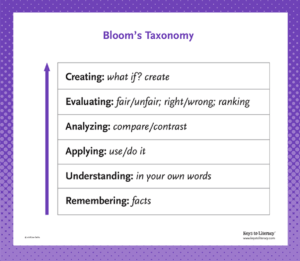
Teach Question Terms
Some students are not able to generate or effectively answer questions, including those on standardized tests because they are not familiar with question terms. Thus, an important component of instruction for question generation is teaching question terms and phrases for prompts. A related scaffold for this is to provide a list (or hang a poster) of question terms and prompts that are typically associated with each level of thinking. The two handouts below can be downloaded from the free resources page at the Keys to Literacy website.
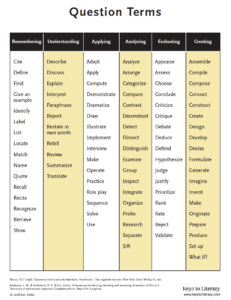
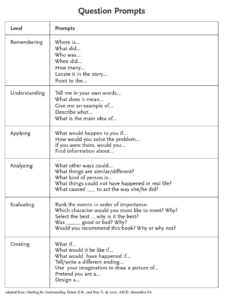
The poster version of the question terms shown below is also available at the Keys to Literacy website.
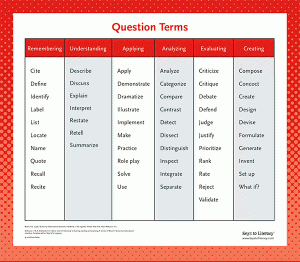
Classroom Examples
The examples below show questions at every level of Bloom’s Taxonomy for different subject areas. At first, the teacher needs to model how to generate questions, then gradually release responsibility to students following this sequence:
- Teach just one or two levels of questions at a time, starting with remembering and understanding.
- Have students work in small groups to identify the level of thinking required to answer a set of sample questions provided by the teacher. Start with questions about familiar topics, then use questions about content reading.
- Have students work in small groups to generate questions about a familiar topic.
- Have students work in small groups to generate questions about content reading.
- Have students work independently in class or for homework to generate their own questions.
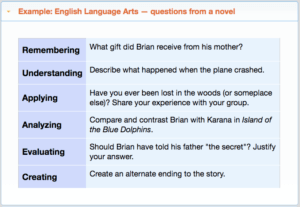

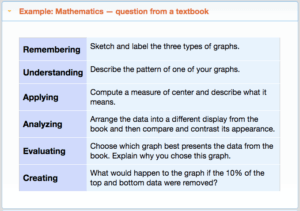
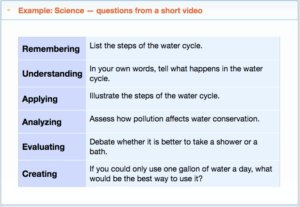
References
Bloom, B.S. (1956). Taxonomy of educational objectives, Handbook I: The cognitive domain. New York, David McKay Co., Inc.
National Institute of Child Health and Human Development. (2000). Report of the National Reading Panel. Teaching children to read: An evidence-based assessment of the scientific research literature on reading and its implications for reading instruction (NIH Publication No. 00-4769). Washington, DC: U.S. Government Printing Office.
Rosenshine, B., Mesiter, C., & Chapman, S. (1996). Teaching students to generate questions: A review of the intervention studies. Reviews of Educational Research, 66 (2).
Trabasso, T., & Bouchard, E. (2002). Teaching readers how to comprehend text strategically. In C.C. Block & M. Pressley (Eds.) Comprehension instruction: Research best practices. New York: Guilford Press.

 Joan Sedita is the founder of Keys to Literacy and author of the Keys to Literacy professional development programs. She is an experienced educator, nationally recognized speaker and teacher trainer. She has worked for over 35 years in the literacy education field and has presented to thousands of teachers and related professionals at schools, colleges, clinics, and professional conferences.
Joan Sedita is the founder of Keys to Literacy and author of the Keys to Literacy professional development programs. She is an experienced educator, nationally recognized speaker and teacher trainer. She has worked for over 35 years in the literacy education field and has presented to thousands of teachers and related professionals at schools, colleges, clinics, and professional conferences.
I love this because I’m always the one asking questions. I think this can work even with younger elementary.. I’m working with my son one on one now and I’m going to get HIM to ask me some questions too to improve his comprehension! Love it, thank you so much!
This is perfect for literature circles! My goal is to get students to ask good questions and have deep, meaningful discussions about the books they are reading. Thanks!
Thank you for sharing this information. I feel empowered by implementing the continuum of thinking to support my students in building on their schema.
Interesting
I love the idea about students creating the questions